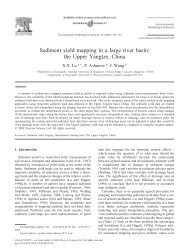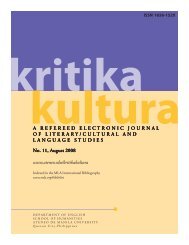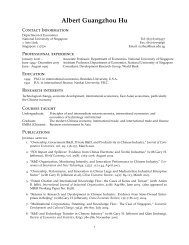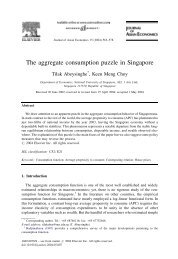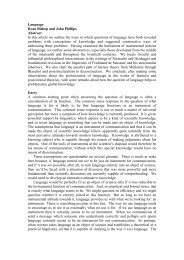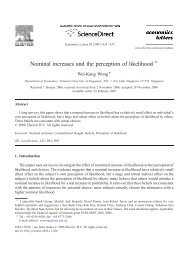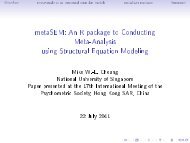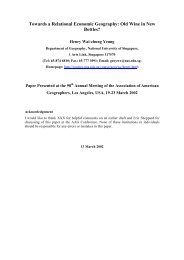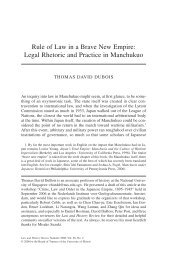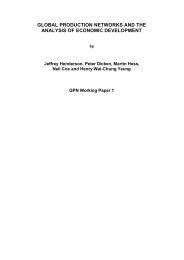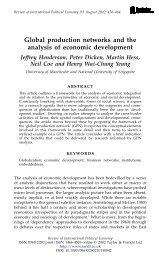Researching Hybridity in Social and Economic ... - NUS Home
Researching Hybridity in Social and Economic ... - NUS Home
Researching Hybridity in Social and Economic ... - NUS Home
You also want an ePaper? Increase the reach of your titles
YUMPU automatically turns print PDFs into web optimized ePapers that Google loves.
<strong>and</strong> production systems resulted <strong>in</strong> a k<strong>in</strong>d of economic geography of firms <strong>and</strong> <strong>in</strong>dustries<br />
devoid of social <strong>and</strong> ethnic identities. With h<strong>in</strong>dsight, the economic geography of the 1980s<br />
appears as “cold”, “<strong>in</strong>human”, “productionist”, <strong>and</strong> “economistic”.<br />
Not surpris<strong>in</strong>gly then, I started my research <strong>in</strong>to Ch<strong>in</strong>ese capitalism with bus<strong>in</strong>ess<br />
firms <strong>in</strong> m<strong>in</strong>d, although I discovered shortly afterwards that I had to open the “black box” of<br />
the firm <strong>and</strong> to focus on social actors <strong>in</strong> my analysis of Ch<strong>in</strong>ese capitalism. In methodological<br />
terms, the crucial role of dense <strong>and</strong> <strong>in</strong>tricate webs of networks <strong>and</strong> relationships <strong>in</strong> Ch<strong>in</strong>ese<br />
bus<strong>in</strong>ess created formidable problems for my empirical research. Though not exclusive, these<br />
methodological problems are related to (1) the unit of research; (2) the discursive identity <strong>and</strong><br />
ethnicity of actors; (3) the spatiality of actors, <strong>and</strong> (4) the role of gatekeepers (or<br />
<strong>in</strong>termediaries <strong>in</strong> actor networks). One of the most daunt<strong>in</strong>g methodological issues was<br />
identify<strong>in</strong>g the unit of research <strong>and</strong> analysis. It was a problem because of Ch<strong>in</strong>ese<br />
capitalism’s extensive regional presence throughout Asia, <strong>and</strong> the dist<strong>in</strong>ctive identities<br />
discursively constructed by host countries <strong>and</strong> among the “Overseas Ch<strong>in</strong>ese” themselves (see<br />
Lim <strong>and</strong> Gosl<strong>in</strong>g, 1983; Wang, 1991; Lynn, 1998). Should the focus be on the family, the<br />
family firm, or the entire network? The complex <strong>in</strong>terconnections among these three<br />
categories have methodologically h<strong>and</strong>icapped previous empirical studies of Ch<strong>in</strong>ese<br />
capitalism. These studies focused exclusively either on Ch<strong>in</strong>ese families <strong>and</strong> their social<br />
practices, or took the family firms out of their social <strong>and</strong> <strong>in</strong>stitutional contexts <strong>and</strong> exam<strong>in</strong>ed<br />
the economic organization of these family firms. This “methodological exclusiveness”<br />
impaired much of their analysis because of the <strong>in</strong>ability to exam<strong>in</strong>e the family, the firm, <strong>and</strong><br />
their networks as total <strong>in</strong>stitutions or <strong>in</strong>tegrated complexes <strong>in</strong> Ch<strong>in</strong>ese capitalism. Today, this<br />
methodological problem cont<strong>in</strong>ues to pose serious implications for decid<strong>in</strong>g what constitutes<br />
appropriate data (see Figure 1). Most quantitative data available on Ch<strong>in</strong>ese capitalism refer<br />
to firm establishments <strong>and</strong>, sometimes, their sharehold<strong>in</strong>g <strong>and</strong> management structures (e.g.<br />
14



